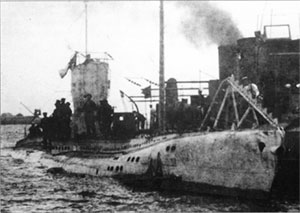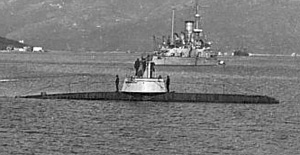Design
German Type U 31 submarines were double-hulled ocean-going submarines similar to Type 23 and Type 27 subs in dimensions and differed only slightly in propulsion and speed. They were considered very good high sea boats with average manoeuvrability and good surface steering.
U-36 had an overall length of 64.70 m (212 ft 3 in), her pressure hull was 52.36 m (171 ft 9 in) long. The boat's beam was 6.32 m (20 ft 9 in) (o/a), while the pressure hull measured 4.05 m (13 ft 3 in). Type 31s had a draught of 3.56 m (11 ft 8 in) with a total height of 7.68–8.04 m (25 ft 2 in – 26 ft 5 in). The boats displaced a total of 971 tonnes (956 long tons); 685 t (674 long tons) when surfaced and 878 t (864 long tons) when submerged.
U-36 was fitted with two Germania 6-cylinder two-stroke diesel engines with a total of 1,850 metric horsepower (1,361 kW ; 1,825 bhp ) for use on the surface and two Siemens-Schuckert double-acting electric motors with a total of 1,200 PS (883 kW; 1,184 shp) for underwater use. These engines powered two shafts each with a 1.60 m (5 ft 3 in) propeller, which gave the boat a top surface speed of 16.4 knots (30.4 km/h; 18.9 mph), and 9.7 knots (18.0 km/h; 11.2 mph) when submerged. Cruising range was 8,790 nautical miles (16,280 km; 10,120 mi) at 8 knots (15 km/h; 9.2 mph) on the surface, and 80 nmi (150 km; 92 mi) at 5 knots (9.3 km/h; 5.8 mph) under water. Diving depth was 50 m (164 ft 1 in).
The U-boat was armed with four 50 cm (20 in) torpedo tubes, two fitted in the bow and two in the stern, and carried 6 torpedoes. Additionally U-36 was equipped in 1915 with two 8.8 cm (3.5 in) Uk L/30 deck guns. The boat's complement was 4 officers and 31 enlisted.
Service history
SM U-36's movements and operations were monitored and reported by British Naval Intelligence, better known as "Room 40". [2] Her first war patrol was in Heligoland Bight from 29 to 30 March 1915; she reported no sinkings during this time. [2] On 23 April, she returned to Heligoland Bight, apparently from a North Sea patrol. [2] [Note 2]
She departed on 29 April, bound again for the North Sea, where she sank the 1,966-ton Danish steamer Lilian Drost on 8 May, captured the 1,241-ton Swedish steamer Björn on 10 May as a prize, while capturing and releasing the 654-ton Dutch steamer Niobe the same day. [2]
U-36 returned to her North Sea station on 17 July. Operating off the north and northwest coast of Scotland, she sank three steamers and almost a dozen smaller vessels. On 22 July, the 3,644-ton Russian Rubonia fell victim. That same day, U-36 also attacked a group of fishing vessels west of the Orkney Islands, sinking nine small trawlers and two sailing vessels, while taking one prize. The following day, the 1,505-ton Frenchman Danae was stopped according to prize rules and sunk, and the 3,819-ton Norwegian Fimreite was sunk as well. [2]
On the day she was sunk, U-36 intercepted and captured the American windjammer Pass of Balmaha, bearing a cargo of cotton intended for Russia and en route to Kirkwall to be inspected by British authorities. An ensign from U-36 was left aboard the windjammer to ensure her successful passage to Cuxhaven. Pass was refitted as a merchant raider and re-christened Seeadler, commanded by Count Felix von Luckner, [4] soon to become famous for her naval exploits in the Atlantic and Pacific.
Fate
U-36 was sunk in the afternoon of 24 July 1915 in combat off the coast of North Rona in the Outer Hebrides with the British Q-ship [2] [Note 3] Prince Charles, commanded by Lieutenant Mark Wardlaw, Royal Navy. The submarine had just stopped and boarded the Danish vessel SS Luise and a boarding party was in the process of dumping her cargo when a lookout sighted an approaching steamer. U-36 sailed towards the disguised Prince Charles and ordered her to stop while firing at her. The Q-ship complied, swinging out her boats. The unsuspecting submarine came within about 600 m (660 yd) of the ship when Prince Charles hoisted the British flag of war and commenced firing. Taken completely by surprise, U-36 took several direct hits and heavy damage, and sank. When Luise moved to pick up the survivors floating in the water, Prince Charles fired into her, believing her to be a German resupply vessel. Forty-five minutes after U-36 sank, the remaining survivors were picked up by the Q-ship. Kptlt. Graeff and 15 crewmen were saved, but 18 others were lost. U-36 was the first U-boat sunk by Q-ship, and one of only a handful to fall victim. Lieutenant Wardlaw received a Distinguished Service Order for the action, and two of his crew received Distinguished Service Medals. The merchant crew of the Q-ship was awarded a prize sum of £1,000, to be divided amongst themselves. [5]

Seiner Majestät UB-4 was a German Type UB I submarine (U-boat) in the German Imperial Navy during World War I. She was sunk by a British Q-ship disguised as a fishing smack in August 1915.
SM U-32 was a German Type U 31 U-boat of the Imperial German Navy.

SM U-35 was a German U 31-class U-boat which operated in the Mediterranean Sea during World War I. It ended up being the most successful U-boat participating in the war, sinking 220 merchant ships for a total of 505,121 gross register tons (GRT).

SM UB-46 was a Type UB II submarine or U-boat for the German Imperial Navy during World War I. UB-46 operated in the Mediterranean and the Black Seas, and was sunk by a mine in December 1916.

SM U-17 was a German submarine during World War I. U-17 sank the first British merchant vessel in the First World War, and also sank another ten ships, damaged one ship and captured two ships, surviving the war without casualty.
SM U-66 was the lead ship of the Type U-66 submarines or U-boats for the Imperial German Navy during World War I. The submarine had been laid down in Kiel in November 1913 as U-7, the lead ship of the U-7 class for the Austro-Hungarian Navy. They became convinced after the outbreak of war in August 1914 that none of these submarines could be delivered to the Adriatic via Gibraltar, and sold the entire class, including U-7, to the German Imperial Navy in November 1914.
SM U-70 was a Type U 66 submarine or U-boat for the German Imperial Navy during the First World War. She had been laid down in February 1914 as U-11 the final boat of the U-7 class for the Austro-Hungarian Navy but was sold to Germany, along with the others in her class, in November 1914.
SM UB-47 was a Type UB II submarine or U-boat for the German Imperial Navy during World War I. UB-47 was sold to the Austro-Hungarian Navy during the war. In Austro-Hungarian service the B was dropped from her name and she was known as SM U-47 or U-XLVII as a member of the Austro-Hungarian U-43 class.

SM UB-43 was a Type UB II submarine or U-boat for the German Imperial Navy during World War I. UB-43 was sold to the Austro-Hungarian Navy during the war. In Austro-Hungarian service the B was dropped from her name and she was known as SM U-43 or U-XLIII as the lead boat of the Austro-Hungarian U-43 class.

SM UB-10 was a German Type UB I submarine or U-boat in the German Imperial Navy during World War I.
SM UB-12 was a German Type UB I submarine or U-boat in the German Imperial Navy during World War I. The submarine disappeared in August 1918.
SM UB-13 was a German Type UB I submarine or U-boat in the German Imperial Navy during World War I. The submarine was probably sunk by a British mine net in April 1916.

SM UB-16 was a German Type UB I submarine or U-boat in the German Imperial Navy during World War I. The submarine was sunk by a British submarine in May 1918.
SM UB-17 was a German Type UB I submarine or U-boat in the German Imperial Navy during World War I. The submarine disappeared during a patrol in March 1918.

SM UB-2 was a German Type UB I submarine or U-boat in the German Imperial Navy during World War I. She sank eleven ships during her career and was broken up in Germany in 1920.
SM UC-36 was a German Type UC II minelaying submarine or U-boat in the German Imperial Navy during World War I. The U-boat was ordered on 20 November 1915 and was launched on 5 June 1916. She was commissioned into the German Imperial Navy on 10 October 1916 as SM UC-36. In five patrols UC-36 was credited with sinking 24 ships, either by torpedo or by mines laid. UC-36 was rammed and sunk by the French steamer Molière off Ushant on 21 May 1917.
SM U-92 was one of 329 submarines serving in the Imperial German Navy in World War I. She was engaged in the commerce warfare in the First Battle of the Atlantic.

SM U-65 was one of the 329 submarines serving in the Imperial German Navy in World War I. U-65 was engaged in the naval warfare and took part in the First Battle of the Atlantic.
SM U-78 was one of the 329 submarines serving in the Imperial German Navy in World War I. U-78 was engaged in the naval warfare and took part in the First Battle of the Atlantic as a minelayer. On 27 October 1918 low frequency communications from U-78 in the Skagerrak were detected by the British submarine HMS G2 which sank her with the loss of her crew of 40. The commonly listed sinking date of 28 October 1918 is in error.

SM UB-50 was a German Type UB III submarine or U-boat in the German Imperial Navy during World War I. The U-boat was ordered on 20 May 1916. She was commissioned into the Pola Flotilla of the German Imperial Navy on 12 July 1917 as SM UB-50.
This page is based on this
Wikipedia article Text is available under the
CC BY-SA 4.0 license; additional terms may apply.
Images, videos and audio are available under their respective licenses.











